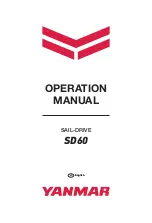MPC555
/
MPC556
QUEUED SERIAL MULTI-CHANNEL MODULE
MOTOROLA
USER’S MANUAL
Rev. 15 October 2000
14-17
Table 14-13 SPCR0 Bit Descriptions
Bit(s)
Name
Description
0
MSTR
Master/slave mode select
0 = QSPI is a slave device and only responds to externally generated serial transfers.
1 = QSPI is the system master and can initiate transmission to external SPI devices.
1
WOMQ
Wired-OR mode for QSPI pins. This bit controls the QSPI pins regardless of whether they are
used as general-purpose outputs or as QSPI outputs, and regardless of whether the QSPI is en-
abled or disabled.
0 = Pins designated for output by DDRQS operate in normal mode.
1 = Pins designated for output by DDRQS operate in open drain mode.
2:5
BITS
Bits per transfer. In master mode, when BITSE is set in a command RAM byte, BITS determines
the number of data bits transferred. When BITSE is cleared, eight bits are transferred regardless
of the value in BITS. In slave mode, the BITS field always determines the number of bits the QSPI
will receive during each transfer before storing the received data.
Data transfers from 8 to 16 bits are supported. Illegal (reserved) values default to eight bits.
shows the number of bits per transfer.
6
CPOL
Clock polarity. CPOL is used to determine the inactive state of the serial clock (SCK). It is used
with CPHA to produce a desired clock/data relationship between master and slave devices.
0 = The inactive state of SCK is logic zero.
1 = The inactive state of SCK is logic one.
7
CPHA
Clock phase. CPHA determines which edge of SCK causes data to change and which edge
causes data to be captured. CPHA is used with CPOL to produce a desired clock/data relation-
ship between master and slave devices.
0 = Data is captured on the leading edge of SCK and changed on the trailing edge of SCK.
1 = Data is changed on the leading edge of SCK and captured on the trailing edge of SCK
8:15
SPBR
Serial clock baud rate. The QSPI uses a modulus counter to derive the SCK baud rate from the
MCU IMB clock. Baud rate is selected by writing a value from 2 to 255 into SPBR. The following
equation determines the SCK baud rate:
for more information.
Table 14-14 Bits Per Transfer
BITS[3:0]
Bits per Transfer
0000
16
0001 to 0111
Reserved (defaults to 8)
1000
8
1001
9
1010
10
1011
11
1100
12
1101
13
1110
14
1111
15
SCK Baud Rate =
f
SYS
2 x SPBR
F
re
e
sc
a
le
S
e
m
ic
o
n
d
u
c
to
r,
I
Freescale Semiconductor, Inc.
For More Information On This Product,
Go to: www.freescale.com
n
c
.
..

















